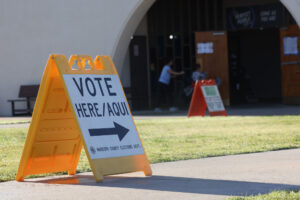- Slug: Spotting Disinformation. 490 words.
- File photo available (thumbnail, caption below).
By Ana Burk
Special for Cronkite News
PHOENIX – In this era of social media, a seasoned political reporter shares key strategies for identifying disinformation during election season.
The American Psychological Association reports that over the past few decades, people’s attention spans have decreased due to constant distractions from phones and other devices. People tend to only read the first line of a story, or watch the first few seconds of a video.
This epidemic of short attention spans affects how people consume media, and in turn, how they get their information. Political reporter Jessica Boehm offered tips and red flags on how to navigate disinformation.
The red flags
Boehm, a Phoenix reporter at Axios, said to be wary of extremes or information that seems too perfect.
Be wary of extremes: Boehm said if people are speaking in superlatives like the absolute worst or best, these exaggerations could be disinformation.
Is the information too perfect?: Nine years ago, Boehm saw on Facebook that the ‘90s sitcom “Friends” was going to have a reunion. As a fan, Boehm was ecstatic, but she quickly discovered the story wasn’t true.
“If something feels a little too good to be true or it proves your point of view,” Boehm said, then you should ask yourself: “Could this possibly be real?”
The do’s
When reading a story, Boehm explains how to get to the facts.
Verify everything: If you’re unsure, do a little research. If there are several credible outlets saying the same thing, then it is safe to assume that information is true. A few ways to fact check information are FactCheck.org, Snopes.com, Washington Post Fact Checker and PolitiFact.
Find the source: The SIFT method, developed by Mike Caulfield, suggests looking up the author and publisher of the information, which can lead to more information about their mission or hidden biases.
Be equally skeptical: “You really need to show the same amount of scrutiny to everyone,” Boehm said. Even if a source has been credible in the past, it’s no excuse to blindly trust them in the future.
The don’ts
Boehm also explains what not to do.
Don’t trust everything on social media: When posting on social media, people tend to sensationalize facts in order to get more clicks. It is dangerous to believe everything you see on social media.
Don’t assign blame: The person spreading the misinformation or disinformation may honestly believe what they are posting is true. Assigning blame can fuel the spread of disinformation. “It’s not always done in a way that’s meant to be malicious,” Boehm said.
Don’t assume people in authority are credible: It is easy to think that someone in power is trustworthy, especially if you typically agree with them. However, having a high position does not automatically mean someone is correct.
As you conduct research to make an informed decision, take a moment to pause and reflect.
“It’s sometimes very hard to know what is disinformation,” Boehm said.
For more stories from Cronkite News, visit cronkitenews.azpbs.org.
